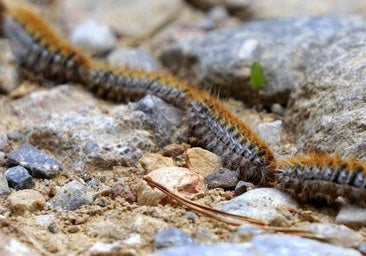Malaga targets processionary caterpillars which can be lethal to pets and dangerous to humans
Council workers are using various weapons and biological products to prevent the proliferation of these pests in the run-up to spring
Malaga city council has started treating parks and forest areas with pine trees in a bid to kill off processionary caterpillars.
The pests usually appear in spring, although drought and warmer weather can cause them to appear during other periods of the year. Pine processionary caterpillars pose a real risk to people and pets because of their high stinging power. After feeding for months in trees, these caterpillars descend in procession to the ground after winter, hence their name, with their venom dangerous for babies and small children and deadly for dogs and other animals.
Each of these insects has about 500,000 venomous hairs in the form of imperceptible darts or arrows. Their tiny size and the possibility that they are easily detached increase the risk of hives and inflammation not only through direct contact but also via the air. It is an insect that shies away from high levels of humidity.
By zones
The prevention work, which is being carried out by crews equipped with a spray cannon and a long-range gun for spraying phytosanitary products, has already been carried out in the forest area near La Caja Blanca and Torre Atalaya and the Gibralfaro, Lagarillo Blanco and Hacienda Clavero forest parks. Work will also be carried out in the Comandante Benítez, La Pelusa and El Polvorín parks, in the municipal forest areas of Cerrado de Calderón, La Cónsula and El Retiro, as well as in Monte Victoria, Monte Calvario-Seminario, San Antón, the forest parks of Virreinas, La Concepción and Correcciones Hidrológicas de la Margen Oeste del río Guadalmedina; Las Palmeras, Galeno forest area and the La Concepción botanical-historical garden forest route; the area around the municipal animal protection centre; and in other smaller zones. In areas where there is a greater influx of people, treatment is carried out at night.
Canary Island pine
The actions, which form part of the maintenance work on the forest areas awarded to the company Perica, will also be extended to all the municipal maintenance areas of El Atabal, where the Canary Island pine, a species that is most affected by this pest, predominates.
It is also planned to carry out work in schools and in pine trees located in areas near nursing homes, children's playgrounds, nurseries or health centres. Once this treatment has been completed, fortnightly monitoring is then carried out to detect if follow-up interventions are required.
Biological and non-toxic
The treatment applied is biological and non-toxic, complying with the sustainable use of phytosanitary products that respect the environment and people's health.
As in previous years, the work consists of spraying the bacterium on pine needles at a dose of 32%, which is the dose set by the ministry for ecological transition.


_20241127120349-U22013314750XDS-1200x840@Diario%20Sur.jpg)